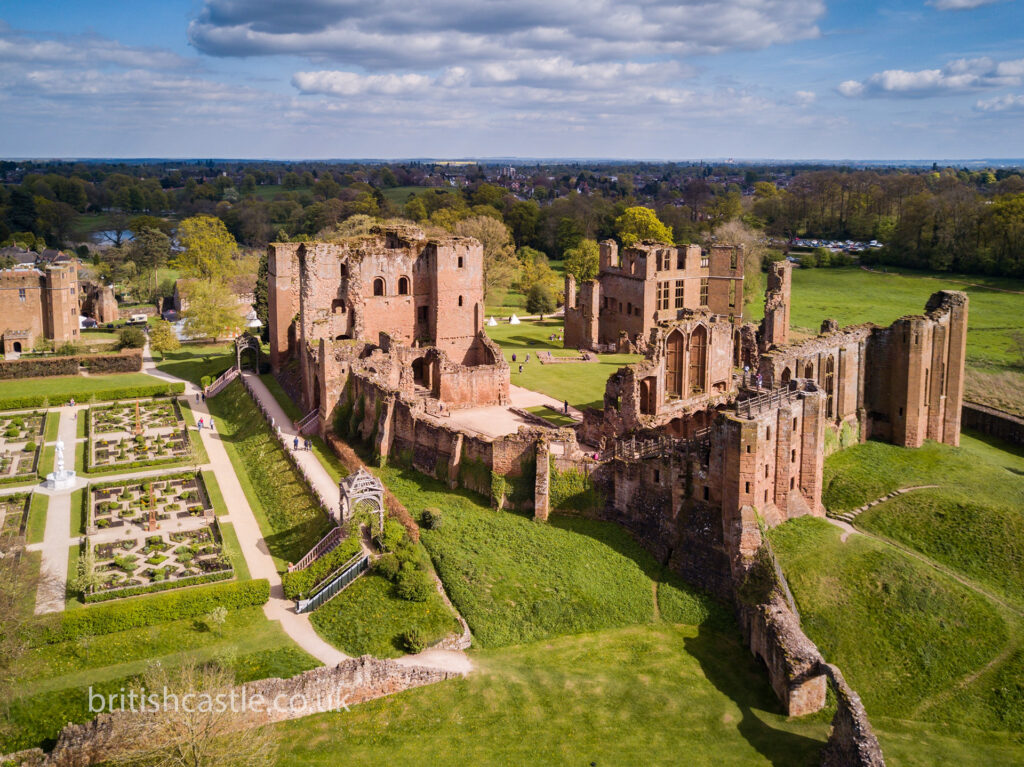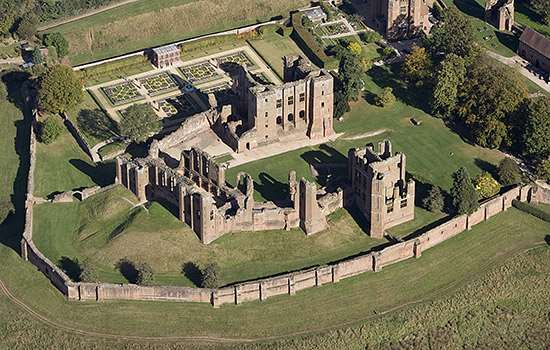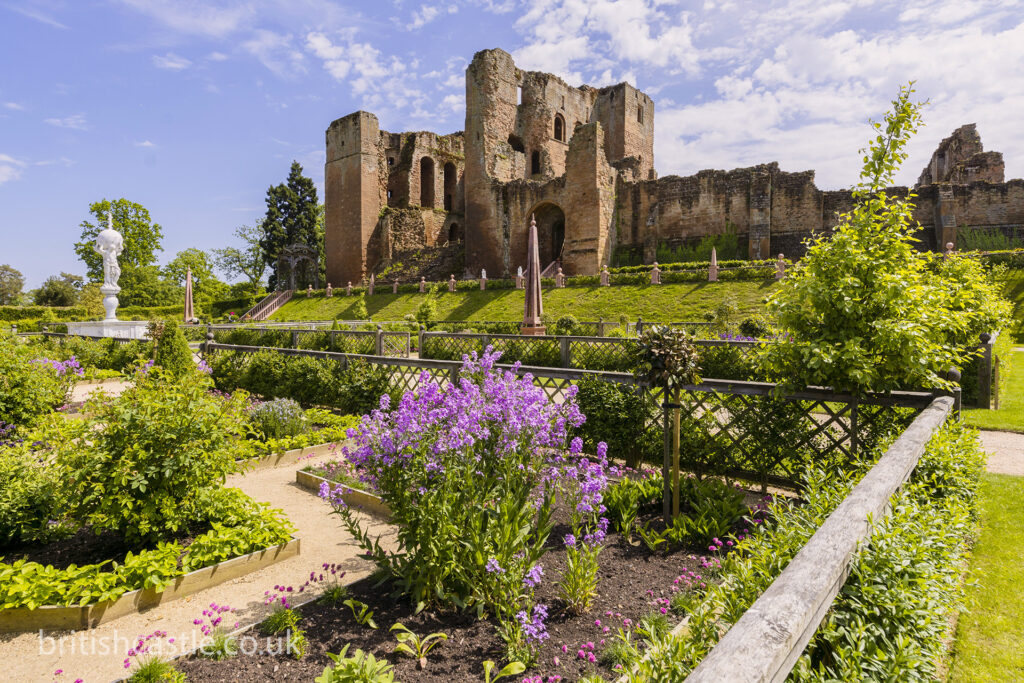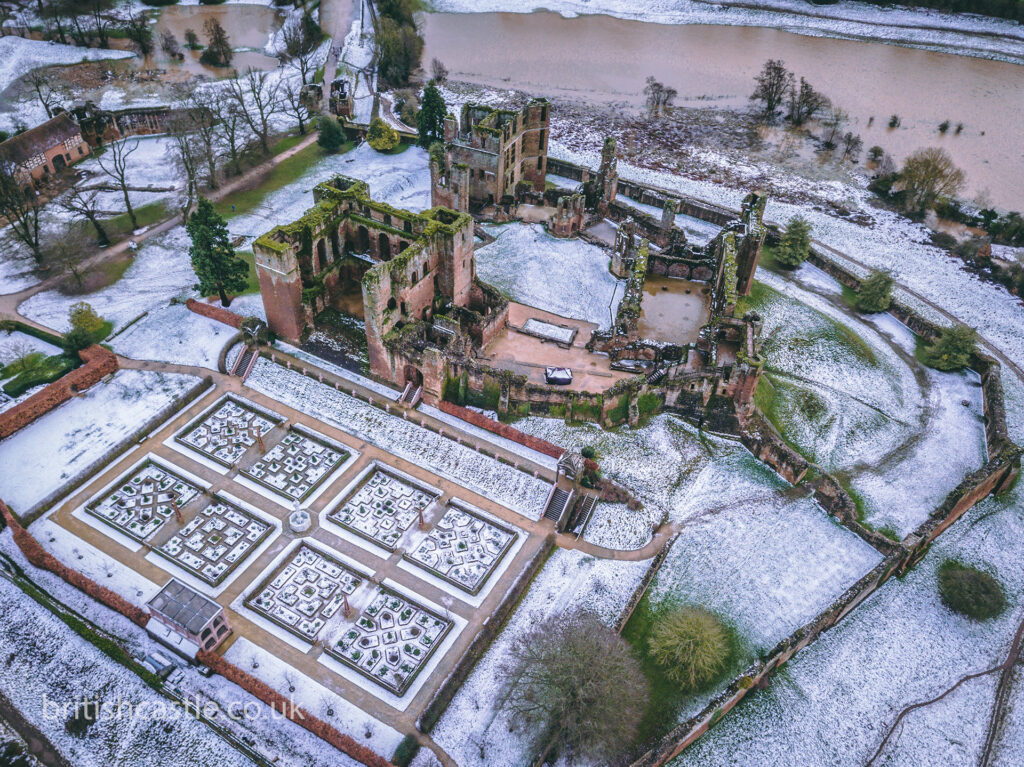Kenilworth Castle is a ruined castle located in the town of Kenilworth in Warwickshire, England. The castle was originally built as a Norman fortress in the 12th century and was later expanded and improved by various owners over the centuries, including King John, Henry III, and Queen Elizabeth I.
Notably, Edward II’s historical association with Kenilworth Castle is marked by his imprisonment there, a significant event that underscores the castle’s role in the power struggles of medieval England.

Kenilworth Castle played an important role in British history for over 500 years. The site was fortified by the Saxons, and Kenilworth is mentioned in William the Conqueror’s Domesday Book of 1086. The castle is built almost entirely from local new red sandstone. Among its most famous residents was the favourite Robert Dudley, Earl of Leicester, who was granted the castle in 1563 by Queen Elizabeth I. Dudley made extensive renovations to transform Kenilworth Castle into a lavish palace, hoping to marry the queen and reflecting the architectural fashions of the time.
Kenilworth Castle History
In 1120 Geoffrey de Clinton erected the first castle at Kenilworth. In 1173 the palace became a Royal Castle. King Edward II was known to consider petitions at Kenilworth, reflecting its role in the governance of the realm. In 1252, Henry III gave it away to Simon de Montfort, Earl of Leicester, who played a strategic role during the Second Barons’ War.
The castle’s significance in medieval English history was further highlighted when the king’s army besieged it at the end of the Barons’ War in 1266. King Edward III and his son John of Gaunt significantly contributed to the castle’s architecture, transforming it into a royal palace fit for a prince. King Henry, including King Henry III, held court here, with the castle witnessing spectacular tournaments and chivalric displays. The castle was handed to John of Gaunt, son of Edward III, and later became a royal palace again. The castle was leased by John Dudley, the Duke of Northumberland, in 1553.
One of the most significant events in the castle’s history was the six-month siege it endured during the English Civil War in 1649. The castle was captured by Parliamentary forces and was subsequently slighted (damaged) to prevent it from being used again as a fortress.
Kenilworth Castle Elizabethan Gardens with Marble Fountain
The castle went through several transformations over the centuries. The Norman earth and wood castle became a local sandstone castle with improved defences. This in turn was redesigned to focus on comfort and luxury rather than strength of defence, eventually becoming an Elizabethan style palace. In its final incarnation, the castle’s gatehouse was transformed into a dwelling, while the rest of the castle lay in ruins. Among the highlights of the Elizabethan garden was the marble fountain, celebrated for its exquisite beauty and historical significance, underscoring the garden’s allure and architectural marvel.

The 3-story rectangular keep dates back to the earliest stone construction in the 1100’s, but the changes made over the centuries (such as the larger Tudor windows) are easily visible. Near the keep was the kitchen – kept separate to prevent fire – and other service buildings.
John of Gaunt’s Great Hall
The Great Hall built by John of Gaunt has lost its flooring, but it can be viewed from the under croft or basement. The walls of the hall are still standing, along with evidence of an imposing vaulted ceiling, tall windows, window seats for work requiring more light, and a large fireplace.
Kenilworth Castle featured six towers at different times during its history.
Mortimer’s Tower
Mortimer’s Tower guarded the entrance to the outer bailey, and was essentially a gatehouse. The narrow passage through the tower, with thick walls and arrow slits above, meant that it could be defended by a small force of men.
Lunn’s Tower
Lunn’s Tower was part of the later defensive wall built by King John, and as such was designed for military purposes rather than comfort.
The Water Tower
The Water Tower, on the other hand, was much more comfortable, with ample fireplaces and large windows. It was added to the castle by Thomas, Earl of Lancaster and known as the Water tower because it overlooked the lower pool.
Mervyn’s Tower, Kenilworth Castle
Also known as the Strong Tower, it was known as such because of its unusually robust design, featuring stone vaulting across all floors. The Strong Tower, three floors high, contained domestic facilities such as the pantry and the buttery.
Saintlowe Tower
Finally, Saintlowe Tower and Gaunt’s Tower were built by John of Gaunt to provide luxurious accommodations for himself and for important guests.
Earl of Leicester’s Great Tower
Other buildings at Kenilworth include the gatehouse and living quarters that were constructed by Sir Robert Dudley, Earl of Leicester, during the reign of Elizabeth I.
Dudley, a favourite of Elizabeth, built the living quarters specifically for her visits. Its three stories each contained a group of rooms, including a sitting room, a luxurious bedroom, and special decorative elements such as elaborate fireplaces.

Leicester’s building was four floors high and built in a fashionable contemporary Tudor style with “brittle, thin walls and grids of windows”. The building was intended to appear well-proportioned alongside the ancient great tower, one of the reasons for its considerable height.
Leicester’s building set the style for later Elizabethan country house design, especially in the Midlands, with Hardwick Hall being a classic example. Modern viewing platforms, installed in 2014, provide views from Elizabeth I’s’s former bedroom.
What is Kenilworth Castle famous for?
Kenilworth is a major landmark in British history where the palace has been a royal castle throughout its history, standing among England’s esteemed royal castles known for their historical significance and architectural grandeur. The castle green, remarkable medieval and Renaissance architecture embodies its role as a castle, palace and theatre setting.
Like many once-magnificent castles of Norman and medieval England, Kenilworth was devastated by the Civil War that began in 1642. The castle passed back and forth between the two sides until the Restoration in 1660, and in the course of the battles the outer wall was damaged, one side of the keep ruined, and considerable damage done to the other buildings. The gatehouse was converted to a residence and the rest of the castle was left to decay. By the 19th century the castle was an abandoned ruin.

Kenilworth Castle was purchased in 1937 by Sir John Davenport Siddley and presented to England for preservation of the history contained within its walls. In 1984, maintenance of the castle was taken over by English Heritage.
What was filmed at Kenilworth Castle?
Kenilworth Castle has been used as a filming location for various television shows and movies. Some of the notable films and TV Series that were filmed at Kenilworth castle are:
- The BBC series “Peaky Blinders”
- The TV movie “Henry VIII” (2003)
- The movie “Elizabeth: The Golden Age” (2007)
- The historical drama “The Virgin Queen” (2005)
- The TV series “Merlin”
- The movie “Lady Jane” (1986)
- Episode: Tanks, Rugby and Sandcastles 2012. The crew learns about becoming a knight at Kenilworth Castle; discovers the massive rubbish burning furnaces in London.
Kenilworth Castle Today: An English Heritage Site
Today it is open to the public, so that visitors from England and around the world can appreciate the fascination of the various historical periods and their impact on this site.
Is Kenilworth castle worth visiting?
Kenilworth Castle is a popular tourist attraction, managed by English Heritage. Visitors can explore the castle ruins and learn about its rich history through exhibits and guided tours. The castle also hosts various events throughout the year, including medieval re-enactments and outdoor concerts.
So if that’s the sort of thing that you enjoy doing then absolutely it’s worth a visit to Kenilworth.
Is Kenilworth castle free to National Trust members?
The castle is open almost every day of the year; it is free for members of English Heritage, with an admission fee charged for non-members. The National Trust is a separate organisation to English Heritage. Members of CADW or Historic Scotland can qualify for a discount.
Visitors can enjoy medieval-themed activities and events such as falconry, jousting, and theatre. For more information, visit English Heritage’s Kenilworth Castle site